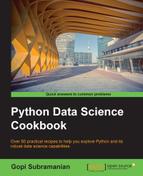True to its name, filter filters elements from a sequence based on the given function. With a sequence of negative and positive numbers, we can use a filter function to, say, filter out all the negative numbers. Filter is a built-in Python function. It takes a function and an iterable for an argument:
Filter(aFunction, iterable)
The function that is passed as an argument is returned as a Boolean value based on a test.
The function is applied on all the elements of the iterable and all the items that are returned as true when the function is applied over them are returned as a list. An anonymous function, lambda, is most commonly used along with filter.
Let's see an example on how to use a filter function:
# Let us declare a list. a = [10,20,30,40,50] # Let us apply Filter function on all the elements of the list. print filter(lambda x:x>10,a)
..................Content has been hidden....................
You can't read the all page of ebook, please click here login for view all page.
